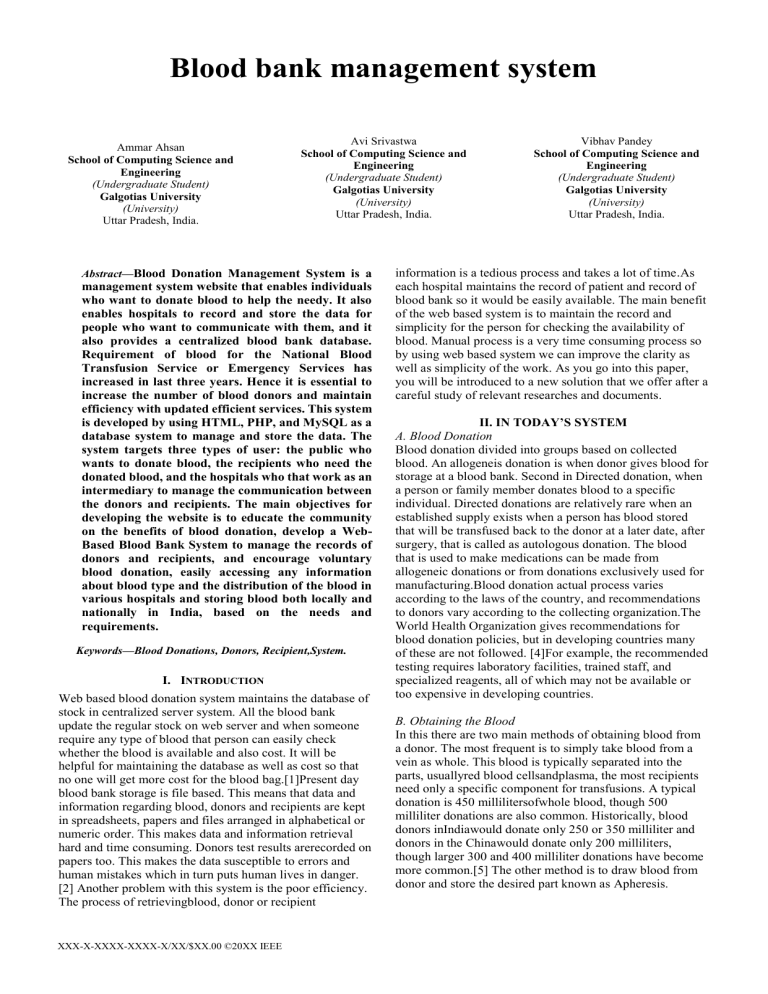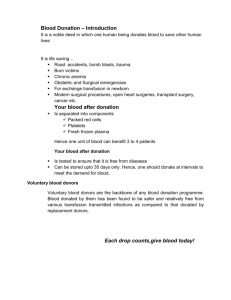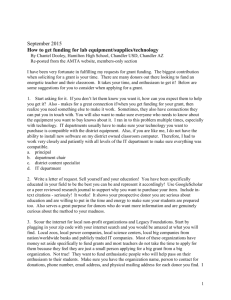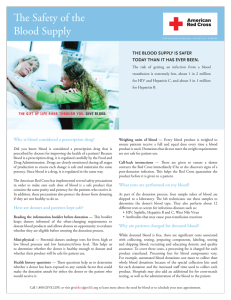
Blood bank management system Ammar Ahsan School of Computing Science and Engineering (Undergraduate Student) Galgotias University (University) Uttar Pradesh, India. Avi Srivastwa School of Computing Science and Engineering (Undergraduate Student) Galgotias University (University) Uttar Pradesh, India. Abstract—Blood Donation Management System is a management system website that enables individuals who want to donate blood to help the needy. It also enables hospitals to record and store the data for people who want to communicate with them, and it also provides a centralized blood bank database. Requirement of blood for the National Blood Transfusion Service or Emergency Services has increased in last three years. Hence it is essential to increase the number of blood donors and maintain efficiency with updated efficient services. This system is developed by using HTML, PHP, and MySQL as a database system to manage and store the data. The system targets three types of user: the public who wants to donate blood, the recipients who need the donated blood, and the hospitals who that work as an intermediary to manage the communication between the donors and recipients. The main objectives for developing the website is to educate the community on the benefits of blood donation, develop a WebBased Blood Bank System to manage the records of donors and recipients, and encourage voluntary blood donation, easily accessing any information about blood type and the distribution of the blood in various hospitals and storing blood both locally and nationally in India, based on the needs and requirements. Keywords—Blood Donations, Donors, Recipient,System. I. INTRODUCTION Web based blood donation system maintains the database of stock in centralized server system. All the blood bank update the regular stock on web server and when someone require any type of blood that person can easily check whether the blood is available and also cost. It will be helpful for maintaining the database as well as cost so that no one will get more cost for the blood bag.[1]Present day blood bank storage is file based. This means that data and information regarding blood, donors and recipients are kept in spreadsheets, papers and files arranged in alphabetical or numeric order. This makes data and information retrieval hard and time consuming. Donors test results arerecorded on papers too. This makes the data susceptible to errors and human mistakes which in turn puts human lives in danger. [2] Another problem with this system is the poor efficiency. The process of retrievingblood, donor or recipient XXX-X-XXXX-XXXX-X/XX/$XX.00 ©20XX IEEE Vibhav Pandey School of Computing Science and Engineering (Undergraduate Student) Galgotias University (University) Uttar Pradesh, India. information is a tedious process and takes a lot of time.As each hospital maintains the record of patient and record of blood bank so it would be easily available. The main benefit of the web based system is to maintain the record and simplicity for the person for checking the availability of blood. Manual process is a very time consuming process so by using web based system we can improve the clarity as well as simplicity of the work. As you go into this paper, you will be introduced to a new solution that we offer after a careful study of relevant researches and documents. II. IN TODAY’S SYSTEM A. Blood Donation Blood donation divided into groups based on collected blood. An allogeneis donation is when donor gives blood for storage at a blood bank. Second in Directed donation, when a person or family member donates blood to a specific individual. Directed donations are relatively rare when an established supply exists when a person has blood stored that will be transfused back to the donor at a later date, after surgery, that is called as autologous donation. The blood that is used to make medications can be made from allogeneic donations or from donations exclusively used for manufacturing.Blood donation actual process varies according to the laws of the country, and recommendations to donors vary according to the collecting organization.The World Health Organization gives recommendations for blood donation policies, but in developing countries many of these are not followed. [4]For example, the recommended testing requires laboratory facilities, trained staff, and specialized reagents, all of which may not be available or too expensive in developing countries. B. Obtaining the Blood In this there are two main methods of obtaining blood from a donor. The most frequent is to simply take blood from a vein as whole. This blood is typically separated into the parts, usuallyred blood cellsandplasma, the most recipients need only a specific component for transfusions. A typical donation is 450 millilitersofwhole blood, though 500 milliliter donations are also common. Historically, blood donors inIndiawould donate only 250 or 350 milliliter and donors in the Chinawould donate only 200 milliliters, though larger 300 and 400 milliliter donations have become more common.[5] The other method is to draw blood from donor and store the desired part known as Apheresis. III. TESTING OF BLOOD Donor's blood type must be determined if the blood will be used for transfusions. The collecting agency usually identifies whether the blood is type A, B, O, or AB and will screen for antibodies to less common antigens. More testing, including across match, is usually done before a transfusion. Group O is often cited as the ‘universal donor’ but this only refers to red cell transfusions. For plasma transfusions the system is reversed and AB is the universal donor . Donated blood is tested by many methods, but core tests recommended by the World Health Organization are these four: Hepatitis B Surface Antigen, Antibody to Hepatitis C, Antibody to HIV, usually subtypes 1 and 2 and Serologic test for Syphilis. In 2006 WHO reported that 56 out of 124 countries surveyed did not use these basic tests on all blood donations[4] IV. LITERATURE REVIEW This section explores literature review A.Bharat Blood Bank in India [2005]. Donors in India who want to donate blood can register at Bharat Blood Bank after reading the basic constraints of donating blood. Bharat Blood Bank requests the donor's name, password, and ID to allow the donor to access his account, which contains information about his date of birth, blood group, gender status, weight, email ID, mobile no, city, address, state, and information about kidney, cancer and heart disease, and date of his last blood donation. After that, the people who need blood can browse the site and display the list of blood donors.BhartBloodBank.com allows recipients to search by area to have more reachable donors. The website provides the phone number to the recipients to make contact with the donor. Also, BharatBloodBank.com provides information about Blood Donation, such as tips, scientific information, facts, etc. It selects other blood banks for blooddonation. BharatBloodBank.com offers these services for free. Further, the site doesn’t use the collected information for any commercial purposes.[6] B. Web-based blood donor MIS in Uganda [2009] A web-based blood Management Information System (MIS) was developed to improve the lives of the vulnerable in Uganda, besides providing adequate supply of blood.The study objectives were to develop a web-basedblood management system to help in the management of blood donors’ records and make it easy to distribute the blood in different parts of the country, based on each hospital’s demands.[7] Fig 1. User Case Diagram Actors and Modules of the systemAdmin-The person who is able to observe and maintain the whole system namely from maintain donor details, update and change database. Donors-A person who can donate voluntarily and has access to an individual account. Acceptors- Anyone who views the system and searches for a particular blood requirement and types in need. B. Design stage: How the proposed system looks like and will be defined and prepared from the requirement specifications that were analyzed and constructed- V.PROPOSED SYSTEM The most important steps that have been taking to build the blood bank system are: A. Initial Stage: Identify the problem. Search for similar research on problem. Determine objective analyze and identify individual’s requirement and type. Fig 2. Prototype Design features implementation of web applications quickly and smoothly.[11] Notepad + +: A source code editor that supports several languages and it uses pure Win32, which allows a high-speed implementation.[12] VI. ARCHITECTURE Fig 3: Donor Search Our new system will be a website hosted on an apache web server. The overall architecture is centralized. In this sense, the system is deployed in a central server while being accessed and collecting data from browsers on different devices in distributed areas. Unlike the existing blood bank management systems, the new system is designed to be used by different blood bank centers while maintaining data security and privacy of individual blood banks but at the same time having the same level of access to other data and information like donors’ and recipients’ information. The new system is designed to be “deployed once and use anywhere” as opposed to some researches that suggest management activities to be implemented on standalone systems that will be deployed on individual computers in the blood bank centers. All System functionalities will be accessible over the internet depending on the type of user accessing the system Fig 4. Database of Members C. Implementation Stage Implementation is the phase of implementing and it will help in putting all the planned activities into action and moving the project to service provision.Languages used to implement blood bank website system are as follows: HTML: Hypertext Markup Language, the basic function is creating web pages. The goal of the web browser is to read the documents as webpages; and it is also possible to include scripts written in several languages, such as JavaScript, which an impact on the behavior of web pages[8] PHP: A scripting language that is integral part of HTML to add functionality that native HTML is unable to do. Originally designed for web development to produce dynamic web pages, “PHP allows you to collect processes and utilize data to create a desired output”.[8] MySQL: A database system, queries, and features easily paired with PHP because it works side by side with ease. Uses MSQL to store manykinds of data, information and graphics. Also it is easily accessible from anywhere in the world.[9] JavaScript: A programming language developed for the design of interactive sites and creating web applications. JavaScript can interact effectively with HTML source code, enabling web authors access to their sites with dynamic content.[10] Programs used to implement blood bank website system are as follows: Dreamweaver: It has many different CSS page layouts that can be used to build efficient and adapt existing pages. It also includes ability to add Ajax functionality to web pages. Ajax Fig 5. Architecture of System VII. DATAFLOW DIAGARAMS VIII. METHODOLOGY Design: First, we will use qualitative research methodology, specifically an interview session with a number of people at a blood donation campaign. This will help us understand the processes involved, activities carried out and the amount of data and information collected during those processes. We will then use the quantitative approach, in this case, document reviews and observation in order to back up the information that we gathered during the interviews. This is necessary as some of the information collected during the interview seems vague and some of the interviewees are likely to give information that varies from the way the real process is undertaken. Approach: We approach this research in two ways. In the beginning, we selected a number of research papers on this field. These papers are all peer reviewed. We then proceeded to extract all the important data pertaining our research. We also tried to acquire some of the forms they use in collecting information of donors. Findings and Discussions Age and gender of blood donors: Data about the gender profile of blood donors show that globally 30% of blood donations are given by women, although this ranges widely. In 20 of the 111 reporting countries, less than 10% donations are given by female donors. The age profile of blood donors shows that more young people donate blood in low- and middle-income countries, proportionally than in high-income countries. Demographic information of blood donors is important for formulating and monitoring recruitment strategies. Fig 6. Age distribution of donors Types of blood donors There are 3 types of blood donors: ● voluntary unpaid ● family/replacement ● Paid. An adequate and reliable supply of safe blood can be assured by a stable base of regular, voluntary, unpaid blood donors. These donors are also the safest group of donors as hospitals and blood centers, donors and recipients. In the the prevalence of blood borne infections is lowest among research, which involved 73 Countries, more than 50% of this group. World Health Assembly resolution (WHA63.12) the blood supply still dependent on family/replacement and urges all Member States to develop national blood systems paid blood donors. This is due to the inadequate knowledge based on voluntary unpaid donation and work towards the on the side of possible donors and poor outreach on the side goal of self-sufficiency. of blood donors. Among these countries: Data reported to WHO shows significant increases of ● countries and 20 are low-income countries. voluntary unpaid blood donations in low- and middleincome countries: ● ● An increase of 8.6 million blood donations from 8 are high-income countries, 45 are middle-income ● 22 countries still report collecting paid donations, around 800,000 donations in total. voluntary unpaid donors from 2004 to 2012 has Global Population and Blood Supply been reported by 162 countries. The highest In a study carried out by Dr. Neelam Dhingra; Coordinator increase of voluntary unpaid blood donations is in Blood Transfusion Safety World Health Organization in the South-East Asia (78%) and African (51%) 2013, a look at the global population and the amount of Regions. The maximum increase in absolute blood supply shows that a total of 107 million blood numbers was reported in the Western Pacific collections from a total of 177 countries. Of these countries, Region. medium-income countries which make 98 of the countries 73 countries collect more than 90% of their blood have the highest supply of blood from both paid and supply from voluntary unpaid blood donations (38 voluntary donations at 72%. 48 high-income countries high-income countries, 26 middle-income countries recorded 49% while the 37 low-income countries recorded and 9 low-income countries). This includes 60 only 12% of the total blood collection. countries with 100% (or more than 99%) of their blood supply from voluntary unpaid blood donors. ● In 72 countries, more than 50% of the blood supply is still dependent on family/replacement and paid blood donors (8 high-income countries, 48 middleincome countries and 16 low-income countries). ● 25 countries still report collecting paid donations in 2012, around 1 500 000 donations in total.[13] Challenges Facing Blood Transfusion in Developing Countries In developing countries like Nigeria, blood transfusion process is plagued with many errors and challenges that Fig 7. Blood Supply among global population. leads to loss of human lives. According to Dr Neelam Dhingra; Coordinator Blood Transfusion Safety World Health Organization Headquarter, the challenges facing blood donation and transfusion include Blood shortages, inequitable access, increasing needs, Increasingly stringent donor selection criteria reducing the pool of eligible donors, poor blood stock management, Inadequate data and documentation as well as the limited interaction between IX. ADVANTAGES OF SYSTEM Advantages of this system will be to the use of technology for maintaining the record and easily available the resource hassle free and in a quick/efficient way. Reduce the paper work and checking availability and keeping online record of stock and money required for blood. Moreover decreasing the time gap between donors and acceptors. Reducing the human error and each hospitals and blood banks can take part in also register on the website and make its own account that contains information about the hospital: the blood types needed and the blood types available. Educating and encouraging the community to take part and know the benefits of blood donation. AUTHORS First Author- Ammar Ahsan (ammarahsan999@gmail.com) Second Author- Avi Srivastwa Third Author-Vibhav Pandey X.CONCLUSION The system eases the access to the blood of different blood groups required by the particular person in need. The user can know about the nearby blood banks depending on it’s location. The system also tells us about the blood stocks as it is regularly updated by the respective blood banks. The overall basic information which is required for the donor is made available in the system hence making it easy for the user to operate.The Blood Donation Management System is 24×7 system which is essential for different kinds of peoplelikeblooddonationsystempersonnel,doctors,donor s,recipientsandothergeneralusers.Hereanyperson who has undergone blood test can be registered in any authorized blood bank as donor. That person can get facilities like information about blood donation system, donors and recipients. This system facilitates services like direct access to the site to get donor’s information if there is an emergency. The goal of the system is to present an online edge for bringing mutually giving blood donors and patients (blood requesters) who need blood. The primary objective of this is to create an interactive blood donors, blood requesters and blood bank clinics. This web application system is to be conceived in its current form as a dynamic site requiring constant updates both from the blood donors as well as the blood requesters and is to enable blood donors (volunteer) to place their profile and blood requesters (patients) to publish their requests. REFERENCES [1]International Journal of Scientific and Research Publications, Volume 4, Issue 12, December 20141ISSN 2250-3153 [2]International Journal of Information System and Engineering Vol. 3 (No.1), April, 2015ISSN: 2289-7615 [3] Blood Bank India (2008). Blood Bank India, Retrieved February 10, 2014, from the World Wide Web: http://www.bloodbankindia.net/index.php [4] https://en.wikipedia.org/wiki/Blood_donation [5] http://www.foundation.jovee.in/donateblood.php [6] Bharat Matrimony Group. Bharatmatrimony Group Launches A Noble Non-Profit Social Service Initiative, 2005. [7] Fredrick K. A Web-Based Blood Donor Management Information System for the Red Cross Society, Uganda (Wbbdmi), 2009. [8] https://en.wikipedia.org/wiki/HTML [9]What Are Php And Mysql.2013. Retrieved fromhttp://Php.About.Com/Od/Phpbasics/Ss/Php_Mysql_2. Html [10] http://Www.Webopedia.Com/Term/J/Javascript.Html XI. FUTURE WORK In light with the current development in computing where everything is moving to cloud technology, our system is developed with the future in mind and it is therefore scalable [11]http://Www.Webdesign.Org/Html-AndCss/Articles/Why-Dreamweaver-Has-Become-SoPopular.16996.Html utilize various functionalities. [12] Notepad++. About.2011. Retrieved fromhttp://NotepadPlus-Plus.Org/ [13] http://www.who.int/worldblooddonorday/campaignkit/WB DD_GlobalNeed_Englis On a short-term basis however, we are looking into SMS h.pdf and can easily be transformed into a cloud server that various blood banks can tap into and get required data and integration, where alerts and notifications will be sent to users mobile phones.




